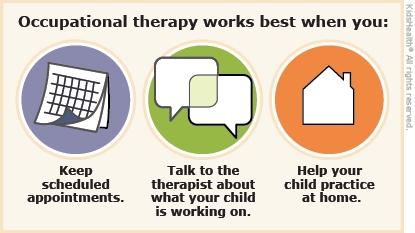An occupational therapist (a medical professional specifically trained to do occupational therapy) uses occupational therapy (OT) movements, exercises, and other methods to help people:
Here's how to help your child get the most out of occupational therapy.


Keep scheduled appointments. Treatment usually includes regular visits to an occupational therapist. The occupational therapist will work with your child and give them occupational therapy exercises to do at home or in school. They might work with your child one on one or in a small group. The occupational therapist may suggest that your child get other types of services, such as seeing a medical specialist or getting additional, school-based occupational therapy.
Talk to the occupational therapist about what your child is working on. This may include:
Help your child practice at home. The exercises your occupational therapist gives your child to practice at home are an important part of helping your child. Be sure you understand all the instructions and can help your child do the exercises as directed.
Be patient with your child. Occupational therapy can take time and effort. Support from family members is important. Celebrate progress, even if it's slow.
Communicate with your child's teachers. Talk with staff at school to see if your child should have an Individualized Education Program (IEP) or a 504 plan. An IEP or a 504 plan can help children get the support they need to be successful at school.


What can I expect at my first appointment? At the first visit, the occupational therapist will ask questions about your child's injury or condition and how it affects their movement and daily life. Then the occupational therapist will create a plan for your child's needs.
How does occupational therapy help? Occupational therapy can:
How long will my child need occupational therapy? It depends on why your child is getting occupational therapy and whether they follow the treatment plan. Some children need occupational therapy only for a short time, while others may need it for many months or even years. Ask your occupational therapist what to expect based on your child's condition and progress.